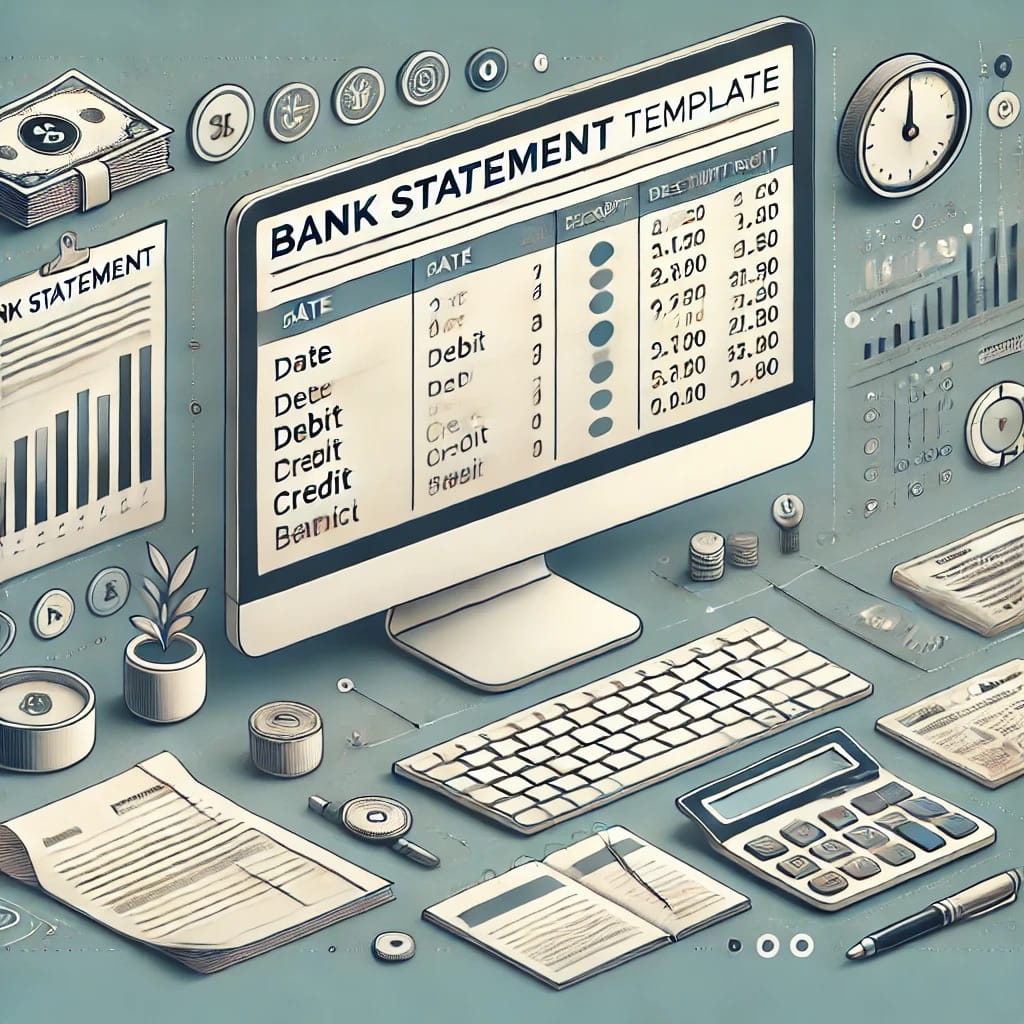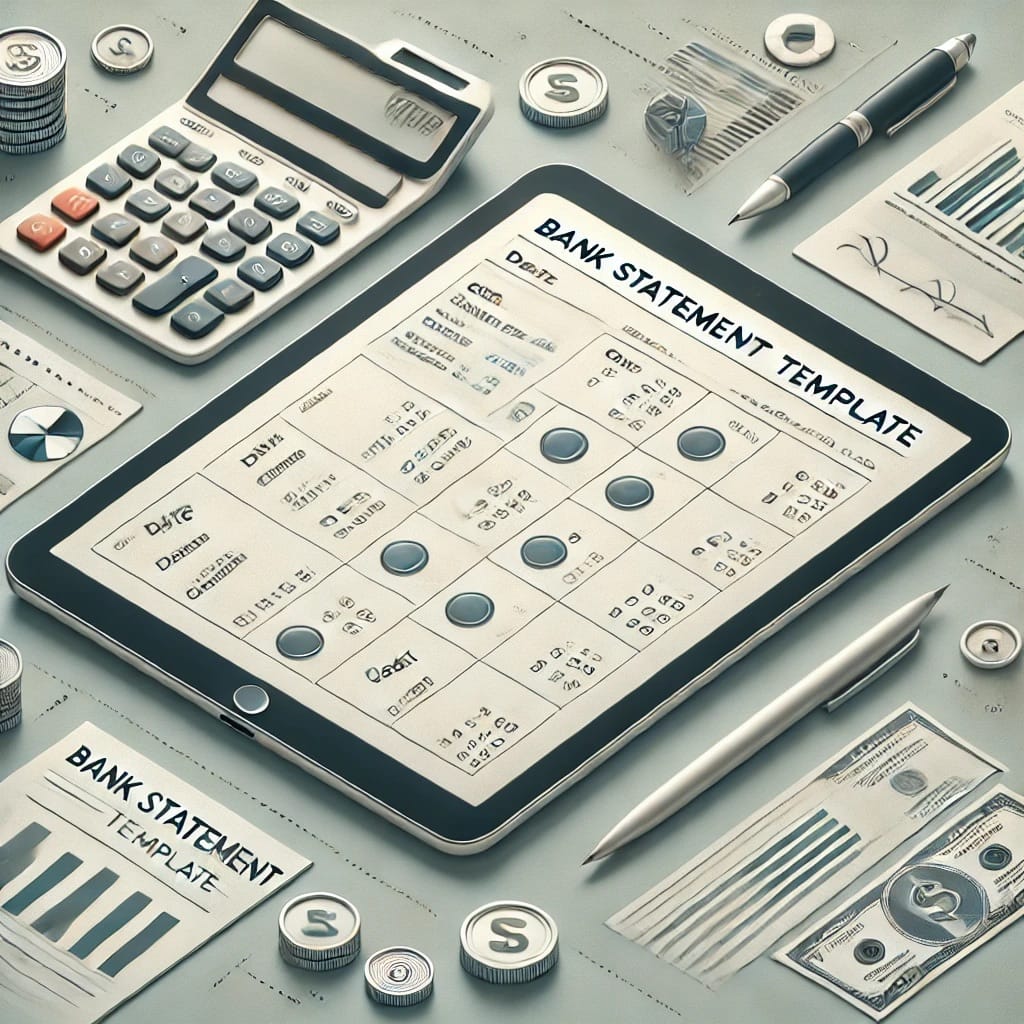Bank Statement Template: Simplify Your Financial Tracking

In today’s fast-paced financial world, keeping track of transactions is essential for personal and business accounting. A bank statement template serves as an organized way to monitor spending, deposits, and overall account balance, making it an invaluable tool for anyone managing finances. With customizable options for monthly, quarterly, or annual tracking, bank statement templates support account reconciliation and simplify financial review processes. In this guide, we’ll explore the benefits of using a custom bank statement, its key components, and how these templates enhance financial management.

What is a Bank Statement?
A bank statement is a document that summarizes all account activities over a specified period, including deposits, withdrawals, transfers, and fees. Traditionally issued by banks, this statement provides a comprehensive record of transactions, helping account holders maintain a clear understanding of their financial health. Key components of a bank statement include:
- Deposits: Funds added to the account, such as paycheck deposits or transfers from other accounts.
- Withdrawals: Outgoing payments or cash withdrawals, including ATM or in-person bank transactions.
- Account Information: Details such as the account number, account holder name, and bank information.
- Statement Period: The dates covering the period of financial activity in the statement.
Bank statements are essential for tracking personal finances and play a crucial role in business accounting by providing the data needed to monitor financial performance and reconcile accounts.
Purpose of Custom Bank Statements
A custom bank statement allows users to design a template tailored to their specific needs. Custom statements are particularly valuable for business owners who require organized, detailed records for tax preparation, budgeting, and financial analysis. Creating a custom transaction record template also makes it easier to spot errors, track recurring expenses, and identify unusual transactions.
Whether for personal or business use, a custom bank statement template provides flexibility, offering a clearer view of financial activity without relying solely on bank-issued statements.
Key Components of a Bank Statement Template
When creating or selecting a bank statement template, there are several essential components to consider. Each element contributes to a comprehensive financial overview, enabling users to track transactions efficiently and accurately.
Bank Information
The template should include details about the bank, such as the bank name, address, and contact information. This information is particularly helpful when using the statement for business purposes or when required for legal documentation.
Account Holder Information
For business or individual records, the account holder’s name and contact information should be prominently displayed to ensure easy identification.
Account Details
This section includes the account number, account title (e.g., “Business Checking” or “Personal Savings”), and other relevant details.
Statement Date
The statement date defines the period covered by the statement, whether it’s monthly, quarterly, or annual. Defining this range allows for easier tracking and ensures that each statement is distinct.
Transaction Details
A chronological list of all transactions during the statement period, including the date, transaction type, description, and amount. This section is crucial for users who need to conduct regular account reconciliation.
Summary
A summary section provides totals for deposits, withdrawals, and the ending balance. This helps users quickly assess the account status at a glance, aiding in financial tracking and budgeting.
Benefits of Using a Bank Statement Template
There are numerous advantages to using a bank statement template, making it a useful tool for both individuals and businesses:
- Identifying Discrepancies: A well-organized bank statement template makes it easier to spot discrepancies or unauthorized transactions, helping to prevent fraud and errors.
- Simplifying Tax Reporting: For business owners, a detailed statement simplifies tax reporting by offering clear documentation of income, expenses, and other financial activities.
- Supporting Decision-Making: By reviewing past financial activities, business owners can make more informed decisions about spending, saving, or investing.
- Efficient Record-Keeping: Templates allow users to keep a structured record of transactions, simplifying account reconciliation and audit processes.
Using a template adds an extra layer of organization, helping users stay on top of their finances and make data-driven decisions.
How to Use Bank Statement Templates
To get the most out of a bank statement template, follow these tips for effective use:
- Reconcile Accounts Regularly: Use the template monthly to reconcile your bank account with actual transactions, ensuring that your records match those of the bank.
- Analyze Spending Habits: Review transaction details to identify patterns in spending or income, which can help in budgeting and financial planning.
- Track Financial Progress: Use templates over time to track financial progress, comparing current balances and trends with past periods.
- Adjust as Needed: Customize the template to fit your unique needs, adding or removing sections based on the level of detail required for your financial tracking.
These simple practices enhance the effectiveness of a bank statement template and promote financial discipline.
Top Free Bank Statement Templates
Several free bank statement templates are available to suit different needs, whether for personal finance tracking or comprehensive business accounting. Here’s an overview of popular options:
Bank Reconciliation Statement Template
The Bank Reconciliation Statement Template is designed specifically for account reconciliation, making it easy to compare transactions and adjust balances. It’s ideal for business owners and accountants needing clear financial accuracy.
Professional Bank Statement Template
This template provides a polished, professional look suitable for presenting financial information to stakeholders. It includes detailed transaction fields and a summary section, making it versatile for both personal and business use.
Excel Bank Statement Template
An Excel bank statement template offers flexibility, allowing users to customize fields, add formulas, and automate calculations. Excel templates are popular for business accounting, as they enable efficient tracking and reporting of financial activities.
Editable Bank Statement Template
An editable bank statement template allows users to adjust layout, colors, and formatting for a personalized design. It’s particularly useful for those who need to tailor the template to match specific branding or document requirements.
These templates provide valuable tools for anyone looking to streamline their financial tracking, whether they prefer a detailed analysis or a simple overview.
Conclusion
A bank statement template is an essential tool for accurate financial management, offering a structured way to track transactions, reconcile accounts, and support sound financial decisions. By customizing templates to suit unique needs, individuals and businesses alike can maintain detailed records, simplify tax reporting, and ensure that financial goals align with daily transactions. Embrace the use of a custom bank statement template to take control of your finances, optimize record-keeping, and make informed financial decisions with confidence.
Source: How to Make Your Own Bank Statement Template
Read also our last article: Enhance Your Projects with a Construction Estimate Template





